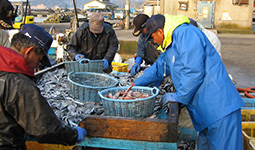Home > Highlighting JAPAN > Highlighting Japan April 2018 > The Maritime Nation of Japan
Highlighting JAPAN


Set Nets for Sustainable Fishing
A sustainable fishing method practiced for centuries by fishermen in Himi City, Toyama Prefecture is now attracting attention around the world.
Facing the Sea of Japan, Toyama Bay in Toyama Prefecture is one of the foremost fishing grounds in Japan. River water containing abundant minerals and other nutrients flows into the Bay from the Tateyama mountain range and surrounding peaks, creating a plankton-rich marine environment in which fish thrive. Toyama Bay is a submarine canyon that suddenly drops off deeply from the coast. The Tsushima Warm Current (surface seawater) traveling the Sea of Japan northward and the cold inherent water of the Sea of Japan (deep seawater) are layered here. Around 600 varieties of fish and shellfish that live in warm and cold water can be caught in the Bay. The specialties of Toyama Bay include broad velvet shrimps in spring, and red snow crabs and yellowtails from fall to winter. In particular, the yellowtails landed in Himi City located on the northwestern section of Toyama Bay from November to February are known throughout Japan by the brand name “Himi kan-buri” (midwinter yellowtails from Himi). They fetch prices more than three times higher than yellowtails landed in other areas in the same season. The reason for their high prices is the method used for catching them, in addition to their good flavor due to abundant fat resulting from their growth in the northern sea and southward migration for spawning.
Traditional set net fishing has been practiced for about 400 years in Himi, which has a well formed continental shelf and attracts many fish in Toyama Bay. Set net fishing is a method of catching only the fish that happen to enter the set nets, without chasing the fish.
“People of Himi refer to yellowtails as gifts from the gods,” says Shingo Ino of the Himi Fisheries Cooperative Association. “We can now catch fish in good condition regardless of the fishing methods used, thanks to the improvement of fishing equipment. We once damaged the fish as a result of fishing that focused solely on chasing shoals. Set net fishing puts no such burden on fish. Fishermen in Himi continue to treat yellowtails carefully even today, lifting them on their two palms.”
Set net fishing is a fishing method that has been practiced in many coastal parts of Japan for a long time. The fishermen in the respective regions have improved and developed this fishing method through information exchanges. A method developed in Himi spread to fishermen throughout Japan, beginning with the improvements made by the fishermen of Himi in around 1915 to a set net used in Miyazaki Prefecture. This method became known as Etchu set-net fishing after an old name for Toyama Prefecture.
Around forty-five set nets are erected in the ocean, 20 to 100 meters deep and two to four kilometers off the coast of Himi. Some of the large set nets are 700 meters long. The nets are set to catch migratory fish such as tuna, horse mackerel and mackerel, in addition to yellowtails. The fish can swim without difficulty in these large nets. Aside from the large ones, there are set nets in different shapes that take advantage of the habits of fish like sardines and squid that travel from the shore to the open sea. Including those, set nets account for 80% of fishing operations performed in Himi.
The haul of fish is falling year after year in Himi, however. In addition to the effects caused by climate change, indiscriminate offshore fishing using equipment like round haul nets is said to be a major cause of the decline.
“Set nets are distinctive in that fish can enter and leave them freely,” explains Ino. “They also have a setup that allows some fish to escape when a large amount of them swim in. One study group made an investigation into fish and found that set nets catch only 20% of all fish that enter them, or 30% at the most.”
Set net fishing has been attracting growing interest around the world in recent years as a sustainable method of fishing that does not destroy an ecosystem or deplete the fish stocks living there. Set net fishing can save ship fuel and has a lower environmental load because it is performed in locations close to the shore.
Himi City sponsored the International Set Net Fishing summit in Himi jointly with Toyama Prefecture and the Fisheries Agency in 2002. About 1,300 government officials, researchers and people involved in fishing took part in the summit from thirty-five countries and regions, including Thailand, China and Costa Rica. Participants from overseas expressed their desire to adopt Etchu set-net fishing when this fishing method was introduced at the summit. In response, Himi City decided to dispatch researchers and fishermen overseas in cooperation with the Japan International Cooperation Agency. The researchers and fishermen dispatched by Himi City have provided technical guidance on set net fishing in Thailand and Indonesia so far.
“To practice set net fishing, you must inspect the nets every day,” points out Ino. “You need many years of experience and intuition as fishermen to adjust the nets. Set net fishing is relatively inefficient and achieving its spread might be difficult if we think only in industrial terms. But we are practicing set net fishing in order to hand on the sea where fish live to the next generation.”
Families in Himi have passed down a variety of fish cooking methods. They consider eating fish from head to tail without wasting any parts as a matter of course. The sustainable fishing method that does not burden fish has been maintained for 400 years in Himi because a culture of placing high value on fish has taken root among not only the fishermen, but also all the people in the area.
© 2009 Cabinet Office, Government of Japan








